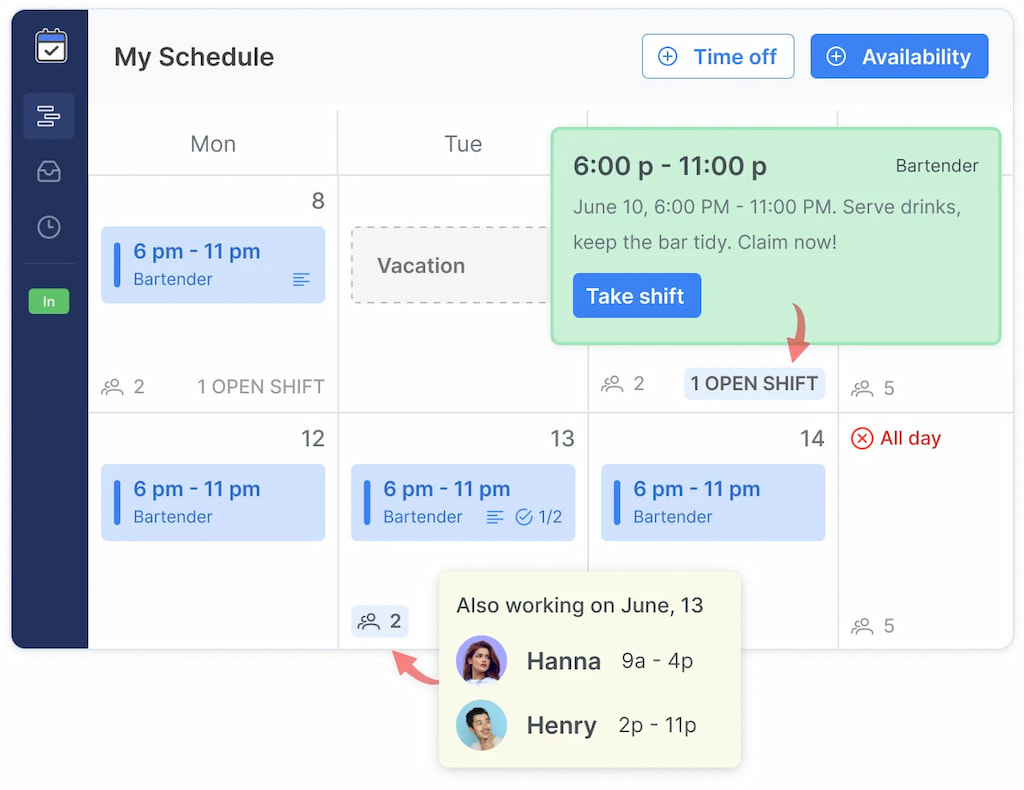If your weekly routine involves scheduling employee shifts with the precision of a NASA launch, we need to talk. You’re not alone. The average manager spends 5–8 hours a week juggling spreadsheets, texting late-night shift reminders, and fielding urgent PTO requests like they’re mission-critical. Except this mission? It’s just trying to make sure three people show up for Thursday’s lunch rush. There’s a better way. And it starts with a simple, scary idea: what if you let your team schedule themselves? No, not total anarchy. Self-service scheduling. Let’s get into it.
The Root Problem Isn’t People—It’s Process
Before we point fingers at employees, let’s call out the real villain: a bloated, fragile scheduling system built on duct-taped spreadsheets, reply-all email threads, and a smudged whiteboard in the breakroom.
That kind of setup leads to:
- ⚡ Constant friction between staff and managers
- 👀 Zero visibility into availability or changes
- 🌀 Unscalable chaos as your team grows
And let’s be honest—most of your time isn’t spent on smart, strategic staffing decisions. It’s spent acting as a go-between for two people arguing over who should work Saturday.
Why Self-Service Scheduling Isn’t a Risk—It’s a Relief
Here’s what actually happens when self-scheduling is done right:
- 🤝 Teams self-regulate — peer accountability kicks in fast
- ⏱️ Managers regain time — no more schedule micromanagement
- 😊 Employee satisfaction climbs — because they feel trusted
Empowerment ≠ chaos.
In most cases, it eliminates chaos—if you build the right framework.
Let’s Define It: What Is Self-Service Scheduling?
It’s a scheduling method where team members can:
- 📅 Set their availability
- 🛫 Request time off
- 🔁 Swap shifts with co-workers
- 🧩 Pick up unassigned or “open” shifts
Managers still have oversight (and veto power), but the day-to-day maintenance? That’s distributed.
Think of it like this:
You create the sandbox.
They build their castles—within the boundaries you set.
The Three Pillars: Availability, Shift Swaps, and Open Shifts
Let’s go deeper into each core function of successful self-service scheduling.
🟢 1. Availability: the foundation of fair scheduling
📌 If you’re still guessing who’s free on Tuesdays or relying on sticky notes to know someone’s off next week—you’re scheduling in the dark.
What self-service availability does:
1️⃣ Gives employees a digital way to update when they can (and can’t) work
2️⃣ Auto-populates your scheduler with conflict alerts
3️⃣ Ensures you’re not assigning shifts to people who can’t show up
Why it matters:
Availability isn’t a suggestion—it’s a commitment. But it should also be dynamic. Life changes. Let your schedule reflect that in real time.
✅ Best practice:
Use a tool that color-codes availability and lets employees update via mobile. If they can’t mark “unavailable” from their phone, they won’t bother.
🔄 2. Shift swaps: adulting in action
⚠️ Shift swaps are where chaos goes to live—unless you have structure.
What great swap systems do:
1️⃣ Let employees propose swaps within the app
2️⃣ Allow for manager approvals (optional)
3️⃣ Keep a log of every swap, so you’re not chasing receipts
Why it matters:
When swaps happen transparently, everyone wins. When they happen on group text threads? You lose. Every time.
💡 Pro tip:
Make it clear that once a swap is approved, the new person owns that shift. No tag-backs. This avoids the dreaded triple-swap spiral that managers love so much.
🧩 3. Open shifts: flexibility without the fire drill
🛠 Open shifts are the secret weapon for coverage gaps.
Instead of begging someone to “please cover Friday,” you post it. First come, first serve. No awkwardness, no manager guilt-tripping.
Why open shifts work:
1️⃣ Reward proactive employees
2️⃣ De-pressure your coverage scramble
3️⃣ Surface who’s engaged (and who’s not)
🎁 Bonus:
It’s a great way for part-timers to grab more hours, which can reduce churn—especially if you let them control when they scale up.
Real Talk: What Could Go Wrong? (And How to Prevent It)
Yes, there are risks. But they’re manageable:
| Risk | Prevention strategy |
| Too many shift changes last-minute | Set swap deadlines (e.g., 24 hours in advance) |
| Unfair shift claiming | Rotate who sees open shifts first or use seniority windows |
| Abusing availability | Limit how often availability can be changed week to week |
| “No accountability” vibe | Make it clear: if you pick it, you own it |
This is where boundaries + automation make the system work.
Real-World Example: When Self-Scheduling Saved the Week
Let’s say you run a small medical clinic. You’ve got a front desk staff of 5, one of whom calls in sick on Monday morning. Instead of diving into panic mode:
- 📱 You open the shift in your app (Shifts by Everhour, obviously).
- 🔔 Two part-timers get an instant notification.
- ☕ One of them claims it before you even finish your coffee.

No back-and-forth. No “can you check with your roommate if you’re free?” That’s the power of proactive coverage. 💪
Cultural Impact: Trust Goes a Long Way
Here’s the hidden ROI: when employees manage their own schedules, they feel respected. 🙌 And when people feel respected? They:
- 1️⃣ Show up on time ⏰
- 2️⃣ Volunteer to help 🤗
- 3️⃣ Stay longer ⏳
Micromanagement breeds disengagement. Autonomy builds buy-in. 🔑 This is especially powerful with Gen Z and millennial workers, who value flexibility more than foosball tables and “culture decks.” 🎯🕹️
Compliance Isn’t Optional—Here’s How to Stay Legal
Now let’s get practical. If you’re in a jurisdiction with labor laws around:
- 1️⃣ Overtime limits
- 2️⃣ Break minimums
- 3️⃣ Rest periods between shifts
…you can’t afford to wing it.
✔️ The right scheduling system will:
- Warn you before assigning illegal overlaps
- Block underage workers from late shifts
- Track swap histories and time-off records
Spoiler: Shifts by Everhour does all of this — quietly, automatically, and without the corporate song-and-dance. 🎯
Let’s Talk Tooling—What to Actually Look For
If you’re evaluating platforms, here’s your real checklist:
| Feature | Why you need it |
|---|---|
| Real-time availability management | Dynamic, conflict-free scheduling |
| Peer-to-peer shift swapping | Empowerment without chaos |
| Open shift claiming | Flexibility for both team and manager |
| Mobile-first interface | Because no one prints schedules anymore |
| Approval workflows | Maintain oversight without bottlenecks |
| Time tracking integration | Tie shifts to actual hours for payroll clarity |
| Compliance alerts | Prevent violations before they happen |
Yes, Shifts by Everhour checks every box. No, it won’t require a six-week onboarding program or an IT support ticket for every edit.
How to Roll Out Self-Service Scheduling Without Breaking Your Team
🚦 1. Pilot with one team or location
Don’t flip the switch all at once. Start small, observe behavior, and adjust.
🎓 2. Train people. Then re-train them
Don’t assume they’ll “just get it.” Walk through the system. Show them the why.
📄 3. Create a clear policy doc
Lay out swap rules, availability deadlines, and expectations.
📢 4. Communicate early and often
Use real examples of how the system works. Celebrate early wins.
📊 5. Measure what matters
Watch KPIs: time saved on scheduling, fewer no-shows, employee feedback.
If adoption is slow? Get curious, not frustrated. Your team may need more visibility or simpler tools.
Manager Mindset Shift: From Gatekeeper to Guide
Empowering your team through scheduling doesn’t mean abdicating responsibility. It means evolving your role from:
- Scheduler → System designer
- Approver → Coach
- Fixer → Facilitator
It’s leadership 101: don’t just solve problems — build a system where fewer problems show up in the first place.
Final Word: Let Go of the Schedule. Keep the Control.
If you’ve ever said, “I just wish they’d take more responsibility,” here’s your shot. Self-service scheduling isn’t a nice-to-have. It’s the future of operational sanity. And it’s not about trusting blindly—it’s about building a structure where trust can live. Less chaos. More ownership. Less time on admin. More time on strategy. And let’s be honest—your team deserves a boss who isn’t up at midnight adjusting shifts. You’re not a calendar. You’re a leader. Time to start scheduling like one.
- Start creating a fair scheduling system with team visibility today and empower your staff with clarity and trust.
- Unlock intelligent scheduling for hourly workers—save time, stay flexible, and keep shifts covered.
- Optimize your workflow today with smart scheduling and management of field service technicians and engineers — save time, reduce errors, and boost team efficiency!

